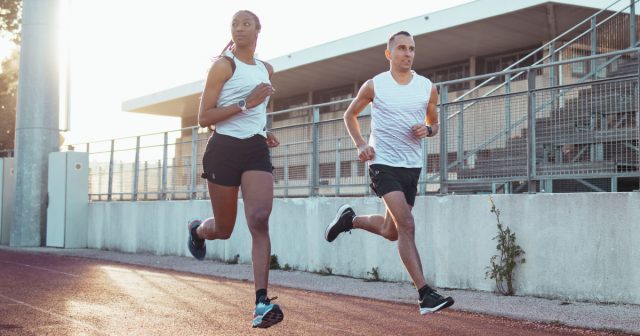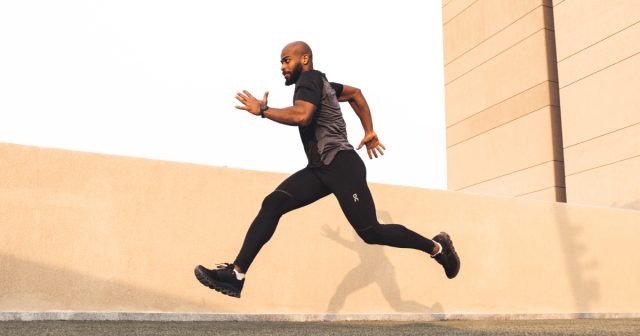You asked and Nick answered! Yes, we challenged running coach Nick Anderson to share his expertise on a selection of your Q&A inquiries about effective ways to use heart rate data analysis for running training.
Check out these great insights for a range of data ideas, including heart rate variability, lactate thresholds, and VO2max.
Here’s how professional coaches use heart rate data for running and recovery – and how you can start seeing results from your running training, too!
Which running metrics should I look at and How Should I Adjust My Training Based On Data?
I still believe that understanding your own rate of perceived exertion (RPE) is the most important thing.
If your heart rate zones (HR zones) are accurate then these will be your main everyday metric. So in zone 2, you should be able to do an easy run, while zone 3 should be your threshold zone for aerobic exercises and zone 5 should be where you’re at for higher intensity VO2 sessions.
Pace is often overrated as it varies for so many reasons but even if it’s just out of curiosity, you can calculate which running pace you should aim for in any give distance.
I always advise checking sleep data and understanding how you feel in a warm-up or the early part of a session. If it’s not happening or you feel tired, pace yourself by trying a quality workout later in the week.
How can I optimize calorie burn during cardio?
Not only is running in your higher zones unsustainable but it will have less impact on your day-to-day metabolic rate.
Running in your threshold zone or higher (zones 3-5) once or twice a week will see the greatest calorific demand. However, these are the areas that you need to recover from the most.
Long runs should be balanced alongside easy recovery runs or training days in the lower intensity zones (zone 2). This will increase aerobic endurance and see your body burn higher percentages of fat at the same time.
Not only is running in your higher zones unsustainable but it will have less impact on your day-to-day metabolic rate. A plan that has easy days and hard days that are achievable in the same week will see a greater calorific burn.
Is it better to train based on heart rate or pace?
Heart rate is more important as it informs your understanding of your training zones.
As I mentioned above, pace will vary depending on terrain, gradient, and the type of run you’re trying to complete. In hilly train, it may be best to train based on HR and running power as they complement each other.
As you get fitter, your pace in zones 2-5 will of course improve.
How should I use a stride sensor for running and what should I do with this stride information?
All stride sensors vary but the key is to make sure you have it calibrated correctly for you.
In general terms, a running cadence (steps per minute) of 180 is desirable. Your cadence will pick up if you run faster or work hard going up a hill.
If your cadence is well below 180, it can suggest you’re overstriding or need to look at your running form and gait.
Pro TiP
Try to have a slight forward lean with your overall posture when you run, keeping your hips high and aiming for the foot to land underneath you, rather than in front of you. This reduces stride length and ground contact, forcing you to keep cadence high and more efficient.
What are the ‘hidden’ key metrics that everybody should know about but don’t?
With Polar products, there are no hidden metrics as all the data is explained openly. However, here are some metrics that people often forget to pay attention to.
Knowing your recovery status is key to ensure you aren’t too tired to train or at risk of overtraining.
Alongside RPE, using your heart rate to calculate if you’re training in the right zones ensures this training is specific and not a wasted or junk session.
Using a Polar product with Running Power will enable your training to be even more effective and dynamic as it monitors the work your muscles do during workouts.
Polar’s new FuelWise is a fantastic tool for understanding your fuel requirements before and during the exercise you’re undertaking.
How do I calculate my maximum heart rate?
You can estimate your maximum heart rate (max HR) by subtracting your age from 220. However, the best way is to have a lab test where they will calculate your max HR along with your VO2max.
Alternatively, you could do your own test. You can try running a good 3k time trial or do some repetitive shorter sprints.
Run 800m (or for 2-3 minutes) really hard, have a short recovery, and then do it again.
You’ll start to feel awful in the second block and begin to struggle and this is when you could get close to your maximum heart rate.
What steps can I take to elevate heart rate variability during non-sleep hours?
There’s lots of talk about using relaxation and breathing exercises during the day to improve your heart rate variability (HRV) and overall wellbeing.
So, how do you know if you’ve recovered? Monitor your recovery.
By allowing your body to recover properly you will reach healthy heart rate patterns.
Moreover, your HRV may go up if you:
- Don’t overdo your caffeine intake.
- Reduce stress factors in your life as much as possible.
- Eat a healthy balanced diet.
Even though most of us want to see results from training, sometimes it’s good to take a more chilled approach and try, for example, mindful running to relax the body and mind.
How can I measure my lactate threshold for running and how should I use It In MY training?
The best way to measure your lactate threshold is to work with a sports scientist or physiologist, either in a lab or field test (lab will be more accurate).
A typical test will involve running on a treadmill for three-minute intervals with your blood lactate levels being measured from your ear (along with your heart rate) between each session. Every three minutes, both the treadmill’s speed will be increased and the gradient will be increased slightly.
The sports scientist will then be able to determine your lactate threshold by looking at the millimoles of lactate in the blood against your heart rate and plotting this all on a graph where the various turn points will be determined.
An easier way for you to gain an idea of your lactate threshold for yourself is to get used to running at around 8-8.5 out of 10. If your RPE feels like zone 4, then you will be running at this threshold.
How is running data useful for a complete beginner?
Data helps you to control your training and not overreach as you build your fitness.
This is a good question. It’s lovely in the early weeks and months of your running to be able to see your fitness changing and not just feel it. Data helps you to control your training and not overreach as you build your fitness.
By monitoring your running data, you’ll be able to see that your heart rate remains more stable (or lower) from runs you previously found hard when your heart rate was high.
If you use heart rate data analysis as your guide in the early weeks and run at a conversational effort (as in, you can talk while running), you’ll build your aerobic fitness gradually and won’t become overtired in runs, have to slow down or stop. This may mean run-walking and gradually introducing more running as you get fitter.
You’ll also see your pace improve running in zone 2, 3 or 4 as you get fitter.
You’ll also notice that you recover more quickly from runs and intervals and should see your resting heart rate (RHR) reduce during the day or even your basal metabolic heart rate (full RHR) reduce at night as a gradual trend as you get fitter over the weeks. This tells you your heart is getting stronger.
How can I use Polar’s Power meter when running?
With Polar Vantage V2 and Polar Grit X, you can measure Running Power straight from the wrist and use it as a metric in your training.
If you’re looking to run faster or short distances (such as a 5k), you’d be wise to do some sessions such as short and fast hill repeats and intervals where you can see your power output increase and improve.
You might also notice your running power reduces during recovery runs — or even clever threshold runs in zone 4 — which means your power economy is improving.
Running power is more instant than heart rate and gives direct feedback, but it works best when used alongside your heart rate and your RPE.
Which is better: training in heart rate zones or pace zones?
Your HR zones should be the priority but always check that your zones are correct.
You may want to make sure that when you’re running in zone 2 it’s an easy conversational run and when you’re running in zone 4 (threshold) it feels like 10k/half marathon effort.
You should see hard intervals at 3k-5k type intensity, pushing you into zone 5. If these things aren’t happening, you may need to adjust your zones. See my above answer about giving 2 x 800m sprints a try when checking or assessing your zones.
You may then want to adjust your running pace on an easy run to check your zones. As you’re now fitter, I would expect your pace to be better in each zone (unless you’re tired or having a very easy day).
How can I transition safely from treadmill running to outdoor running to avoid stress fractures?
I would personally advise any athlete to try and run at least half of their weekly volume on a good safe trail or grass, with the rest being on-road or treadmill.
This is an interesting question as for many, too much treadmill running (recreating the same foot plants over and over on a moving belt) can speed up the incidences of an overuse injury and the likes of a stress fracture.
For others, running outside on an uneven trail type surface can increase the incidence of an overuse injury type fracture scenario.
The key is always to have a good strength and conditioning program in place, working on key running, muscle groups and your own personal assessed weakness.
Add in regular running drills and the right shoes based on a good gait analysis and overuse injuries are immediately reduced.
I would personally advise any athlete to try and run at least half of their weekly volume on a good safe trail or grass, with the rest being on-road or treadmill. Mixing up the surfaces and transitioning between the two is ideal.
When your legs are tired, flat good quality grass is perfect. When the legs feel fine, a harder surface is faster and safer to use.
How should I interpret The Orthostatic Test, especially HRV data?
These tests will indicate ‘recovered’/’not recovered’ but they will also tell you if your fitness is moving in the right direction.
If you feel tired and your RHR is higher, then you are tired. If you feel ok and RHR is trending towards getting lower week by week, and RHR drops more quickly after key sessions during the workout, this is a true indication that you are getting fitter.
You will get faster in each zone the fitter you are without HR rising.
Try to use these tests alongside the way you feel, your general RHR between intervals during the day, and how well or fast you’re able to run in each training zone for the periods of time.
How To track recovery, between running (endurance), weight training, and martial arts training?
Muscle load and cardio load will be key for you here.
It’s entirely possible that you may have recovered from a cardio workout and your heart rate is lower and you feel good but there is still damage to the muscles, which will appear in your cardio load.
So hard training days will be best when cardio load and muscle load together tell you are recovered and easy days should take place when either metric indicates fatigue.
Try to take a balanced approach as each of the disciplines you mentioned cause damage to the body and recovery must be respected.
What’s your experience And Opinion On training With Running Power? Should It Be Used With HR?
Training with Running Power can be very accurate, allowing you to see yourself running faster and developing workouts that challenge you.
In my opinion, power and HR definitely complement each other.
However, in reality, only a very small percentage of the running public have Running Power available to them as a metric. I believe in time, power will be more widely used by runners and understood in a similar way to its growth and use in cycling.
Power is a more instant metric and training with power can be very accurate, allowing you to see yourself running faster and developing workouts that challenge speed.
In addition to using power zones, make sure you’re working efficiently in HR zones or relating to energy use: running power, running heart rate and fueling levels together are important for optimal performance.
does A LOW VO2MAX mean I have to take longer breaks between sessions to fully recover?
It is desirable to improve your VO2max as it is a true indication of your fitness improving. However, there are world-class endurance athletes whose VO2max is a little lower than their competitors, yet their ability to work at a high percentage of their own VO2max for a long time is excellent.
Your work in zone 4 and workouts in zone 2 will determine how long and efficiently you can work at a higher percentage of your VO2max alongside some tough sessions in zone 5.
Don’t always see VO2max as a limited factor and aim to become efficient at work at higher percentages of your own personal VO2max as this develops over the years.
Recovery will ultimately be determined by how hard the workout was for you and even elite athletes can need days and days to recover before their next workout.
If you liked this post, don’t forget to share so that others can find it, too.
Or give it a thumbs up!
I like this article
Please note that the information provided in the Polar Blog articles cannot replace individual advice from health professionals. Please consult your physician before starting a new fitness program.






